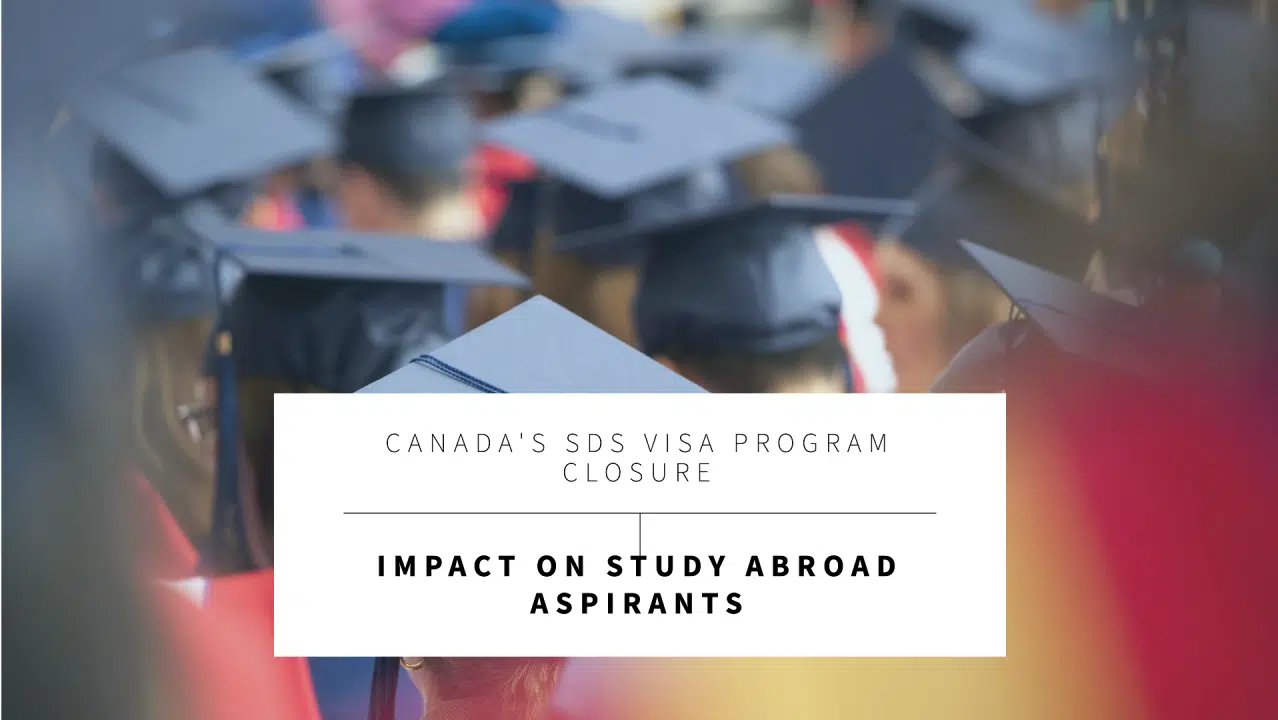Canada has long been a top destination for international students especially from the 14 countries that come under SDS, thanks to its high-quality education, multicultural environment, and robust immigration policies that provide pathways to permanent residency. A critical part of this infrastructure has been the Student Direct Stream (SDS) which was introduced in 2018, with the improvements in its previous program Student Partnership Program (SPP) a streamlined visa process for international students from specific countries. With the recent closure of the SDS program, however, has sent ripples across the international education sector. Let’s explore what the closure of SDS means, its potential positive and negative impacts, and what changes might be on the horizon for Canada’s Non-SDS process.
What Was the SDS Program?
I don’t dive deep into what the Student Direct Stream (SDS) program was. But it was launched to simplify and expedite the visa application process for students from specific countries, including India, China, the Philippines, Pakistan, and several others. Under SDS, students who met certain financial and English language proficiency criteria could benefit from faster visa processing. The SDS program was widely popular, particularly among students from countries like India, due to the efficiency it provided in obtaining a Canadian study permit.
Why Was the SDS Program Closed?
I don’t dive deep into what the Student Direct Stream (SDS) program was. But it was launched to simplify and expedite the visa application process for students from specific countries, including India, China, the Philippines, Pakistan, and several others. Under SDS, students who met certain financial and English language proficiency criteria could benefit from faster visa processing. The SDS program was widely popular, particularly among students from countries like India, due to the efficiency it provided in obtaining a Canadian study permit.
Why Was the SDS Program Closed?
While no official statement has clarified the reasons, several factors may have contributed to the SDS closure:
- Overburdened Visa Processing: With increasing demand, visa processing systems could have been strained, leading to delays even within the SDS category.
- Policy Shifts in Immigration: Canada may be re-evaluating its approach to student immigration to better align with labour market demands and regional priorities.
- Economic and Social Factors: As Canada manages its post-pandemic economic recovery, it may be focusing on ensuring that student visas are equitably distributed across regions and programs.
Potential Impacts of the SDS Closure
1. Positive Impacts
- Greater Equality Among Applicants: With the closure of SDS, all international students might have a more equal footing in visa processing. This could level the playing field for students from countries not previously included in SDS.
- Opportunity for Process Reassessment: This pause allows Immigration, Refugees and Citizenship Canada (IRCC) to assess and improve its visa processing to accommodate larger numbers of applicants effectively.
- Increased Attention on Quality Over Quantity: This shift might encourage students to pursue programs that align closely with Canada’s labor needs, enhancing job prospects post-graduation and making the overall system more sustainable.
2. Negative Impacts
- Longer Processing Times: Without SDS, all applications may revert to standard processing times, which can lead to delays, especially during peak periods. Students may have to plan even further in advance to secure their study permits.
- Increased Financial Pressure: SDS had clear financial and language requirements that, once met, assured students of quicker processing. Now, students might face more uncertainty regarding timelines, impacting financial planning and the possibility of obtaining loans.
- Possible Reduction in International Enrolments: The SDS program was an attractive element for students looking to study in Canada. Its absence could shift some students to other destinations that offer more expedited processing or streamlined pathways.
Considerations for Students Under the Non-SDS Process
With the closure of SDS, all international students will now apply through the Non-SDS process, which has different requirements. Students may need to consider the following:
1. Financial Documentation: Non-SDS applicants typically need to provide more extensive proof of financial support, such as six months of bank statements and additional documentation showing their ability to pay for tuition and living expenses.
2. English Language Proficiency: While SDS required a minimum IELTS score, Non-SDS has broader requirements that may be more favourable to some students. However, meeting high language proficiency levels will still be beneficial for a strong application.
3. Longer Processing Times: With increased application loads under the Non-SDS system, processing times may increase. Students should apply well in advance to ensure they have enough time before the start of their program.
4. Focus on Study Plans and Future Goals: In the absence of SDS’s streamlined nature, applicants may need to provide more detailed information on why they chose their program and how it aligns with their career goals, which could impact their visa approval likelihood.
Will There Be Changes in the Non-SDS Process?
The Canadian government may respond to the increased demand on the non-SDS process by implementing changes. Some possible adjustments might include:
- Enhanced Digital Processing Systems: To manage the increased volume, Canada might invest further in digitizing its application processes, utilizing AI for preliminary checks, and automating repetitive steps.
- Prioritizing High-Demand Programs: Students applying for programs that align closely with labor market demands might receive faster processing.
- Regional Quotas or Prioritizations: To manage demand, Canada may prioritize students applying to institutions outside of major urban centers, in alignment with regional labor shortages.
Risk Analysis for Students
The closure of SDS introduces new risks for students, and careful planning will be necessary:
1. Application Backlogs: With SDS removed, applicants face the risk of backlogs, especially if processing times aren’t managed effectively under the non-SDS structure.
2. Financial Risks: Delays in visa processing can lead to financial losses for students, such as non-refundable tuition fees, rental deposits, or even forfeited scholarships.
3. Uncertain Job Prospects Post-Graduation: Without targeted pathways like SDS, students may face more uncertainty around the pathways to work permits and permanent residency, making it essential to research job availability in their chosen field thoroughly.
4. Competition from Other Study Destinations: Canada may experience a dip in international enrolments, especially if destinations like the UK, Australia, and Germany offer more predictable or faster visa processes.
Final Thoughts
The closure of the SDS visa program marks a shift in Canada’s approach to managing international student applications. While it brings challenges, it also opens doors for a more robust, equitable, and comprehensive approach to international student admissions. Students should remain vigilant, apply early, and stay informed about potential changes to the Non-SDS process to ensure a smooth transition. Ultimately, Canada remains a top destination for international students, and adaptive strategies on both the students’ and government’s part can keep it that way.













